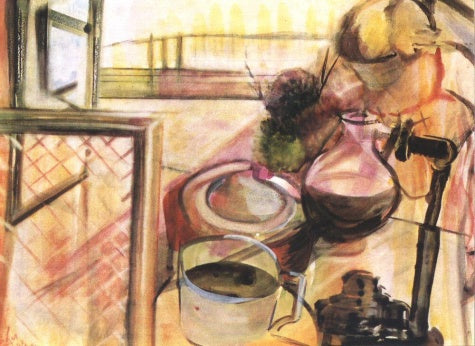Description
Istvan Farkas, acclaimed Hungarian painter of the twentieth century, occupies a unique place in the history of European art. His work "Bodegón with coffee maker - 1943" is a reflection of his mastery in the composition and his ability to imbue his pieces with an emotional resonance that transcends the merely visual. This painting, at first glance, might seem a simple domestic scene, but a closer inspection reveals a conceptual depth that deserves a detailed analysis.
In "Bodegón with coffee maker", Farkas chooses a set of daily elements to compose his scene: a coffee maker, a glass glass and a fruit, all arranged on a table. The choice of these objects is not accidental; Each one plays an essential role in the visual narrative of the work. The coffee maker, located in the geometric center of the painting, It acts as a focal point that attracts the viewer's gaze. Its robust and geometric shape contrasts with the delicacy of the cup and the softness of the fruit, creating a balanced but dynamic visual tension.
Color treatment is particularly notable in this work. Farkas uses a restricted palette, focused on brown, gray and ocher tones, which gives the whole a sober and contemplative atmosphere. This chromatic choice can be seen as a metaphor of European reality in 1943, a time marked by conflict and uncertainty. It is in this historical context that the apparent simplicity of the still life acquires an additional layer of meaning. The artist not only represents objects, but also hints at a narrative of resilience and daily life in difficult times.
Farkas's artistic composition in "Bodegón with coffee maker" is balanced and calculated. The arrangement of the elements follows classic principles of still life, with clear attention to the balance and proportion. The slightly high perspective allows the viewer to look directly at the objects, which facilitates an intimate connection with the scene. In addition, the texture and thorough details in each element demonstrate Farkas's technical ability and his commitment to likelihood.
It is essential to consider the context in which Farkas created this work. Born in Budapest in 1887, Farkas lived during some of the most turbulent periods in European history. His life and his career were marked by the first and Second World War, and these events deeply influenced their art. "Bodegón with coffee maker" is not only a celebration of common objects, but also a silent testimony of an artist who seeks to find stability and beauty in everyday life, in the midst of external agitation.
Farkas, throughout his career, was influenced by various artistic movements, including post -impressionism and surrealism, although he always maintained a distinctive personal style. Works similar to "still life with coffee maker", in terms of their attention to everyday life and the use of composition to generate deeper meanings, can be found in the work of other contemporaries of yours. However, few achieved the same ability to mix the banal with the sublime in the way Farkas did.
In summary, "Bodegón with coffee maker - 1943" by Istvan Farkas is a work that, under its simple and serene surface, hides a sea of complexities, both technical and emotional. This still life is not just a representation of inanimate objects; It is a meditation on the existence, resilience and the role of art in times of adversity. With each stroke and every detail, Farkas invites us to reflect on the interconnection of everyday life with great historical events, reminding us that even in the darkest moments, beauty can be found in the simplest things.
KUADROS ©, a famous paint on your wall.
Hand-made oil painting reproductions, with the quality of professional artists and the distinctive seal of KUADROS ©.
Art reproduction service with satisfaction guarantee. If you are not completely satisfied with the replica of your painting, we refund your money 100%.

